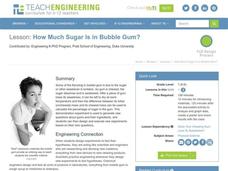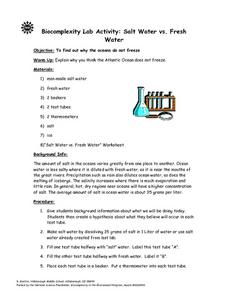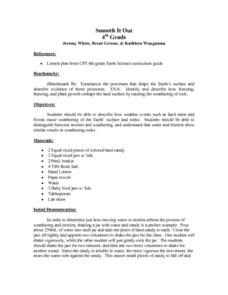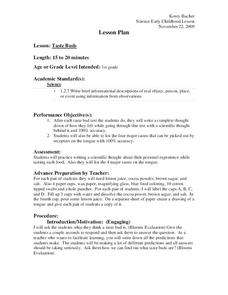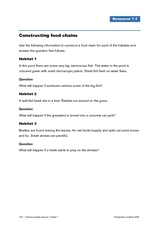Curated OER
Rusting-A Form of Oxidation
Young scholars conduct an experiment to observe oxidation. In this chemistry lesson, students explain how rusting happens. They rank metals according to their conductivity.
Curated OER
Making Soap
Students explore what chemical indicators are and use pH paper to determine if something is alkaline or basic. In this pH instructional activity students manufacture their own soap.
Curated OER
Message in the Bottles
Students identify the three realms of the Arctic Ocean, and describe the relationships among these realms. They explain the relationships between gross primary productivity, net primary productivity, and respiration.
Curated OER
The Nature of Chemical Change: Acting Out An Example
Young scholars illustrate the molecular nature of matter and show that chemical change involves alteration of molecules.
Curated OER
Black Holes Revealed
Students explore the concept of black holes through an interactive program. They explore how they form and what materials form them. They can also visit websites in which they can research radio transmission between the Earth and space.
Curated OER
Tracking Narwhals in Greenland The Ocean Unicorn
Students study the ecology, habitats, geographic range and feeding habits of narwhals. They determine at least three reasons for the decline in the narwhal populations and complete the accompanying worksheets.
Curated OER
Frozen Out
Students investigate how climate changes affect top predators in Arctic marine ecosystems. Students complete a worksheet and write a report based on their responses to a scientific paper.
Curated OER
Infectious Disease Detectives
Learners participate in a simulation of how diseases are transmitted. Each student holds a test tube, with only one containing the "disease" while the others have water. They move around the room until told to stop. Using droppers to...
Curated OER
How Much Sugar is in Bubble Gum?
Students conduct an experiment to determine the percentage of sugar in various types of gum. They weigh the gum after chewing it to determine the amount of mass lost from each piece of gum, analyze the data, and create a graph of the...
Curated OER
Eutrophication Lab
Middle schoolers examine the effects of detergents and fertilizers on aquatic life and describe algae. Students define the term eutrophication as the process by which a body of water, such as a pond, lake, stream, or river, has a sudden...
Curated OER
Water Density and Salinity
Students observe how different water densities control the depth at which different water masses occur. They explain one fact that they comprehend about salt water. Students comprehend that temperature and salinity affect the density...
Curated OER
Salt Water vs. Fresh Water
Middle schoolers explore why the oceans do not freeze. They explain why they think the Atlantic Ocean does not freeze. Students are given background information about what they are doing. They create a hypothesis about what they...
Curated OER
Smooth It Out
Fourth graders describe how weather events such as hard rains and floods cause weathering of the Earth's surface and rocks. They distinguish between erosion and weathering, and comprehend that water and friction show similar results in...
Curated OER
Changes In Matter, Not In Weight
Fifth graders investigate different objects and the examine the correlation of mass and weight. They conduct the experiment with the help of background information provided by the teacher and record observations before making...
Curated OER
Matter for Minors
Young scholars use streaming videos, web sites, and hands on activities students to explore matter. They focus on how temperature affects matter and what the particles look like in the states of matter.
Curated OER
Why Is The Sea Salty?
Students observe how salt concentration increases in water and how salt remains after water evaporates. In this salty sea lesson plan, student use rock salt, water, containers, and strainers to observe that salt increases each time new...
Curated OER
Cell Size and Division or How Big Would You Want To Be if You Were a Cell?
Students investigate why cells divide. In this cell size lesson plan, students observe how far a solution travels into 3 different size model cells of agar. They answer questions about the most effect movement of "nutrients" into the...
Curated OER
Chromatography - Chemical Separation of Colors
Third graders use the scientific method as they separate the colors used in ink. In this chromatography lesson, the teacher introduces students to how chromatography is used in several careers, then students perform an experiment to see...
Curated OER
Bermuda: Search for Deep Water Caves: Living Fossils
Students explore relict species. In this anchialine cave activity, students identify relict species associated with anchialine caves, and explain the importance of preserving anchialine caves and species.
Curated OER
Taste Buds
First graders taste a variety of items and record a full sentence about the way they taste. In this taste buds lesson, 1st graders predict and then taste various items. Students draw a picture of the tongue and show the part that...
Curated OER
Wonders of Weather
Students investigate weather disasters by creating a virtual tornado. In this wild weather lesson, students define a vortex and describe how a vortex keeps a tornado moving and causing damage. Students utilize salt, detergent, water,...
Curated OER
Halogens
Students identify the elements that belong to the halogen family on the periodic table. In this chemistry lesson, students describe the common characteristics of elements in this group. They research about hydrochloric acid's effect on...
Curated OER
Constructing Food Chains
Students explore different habitats and the food chains within. In this food web lesson students construct food chains for different habitats.
Curated OER
Straw Chromatography
Young scholars become acquainted with the principles of liquid chromatography and construct a liquid chromatography column. Students also investigate the effects of different solvents and solvent concentrations in the separation process.










